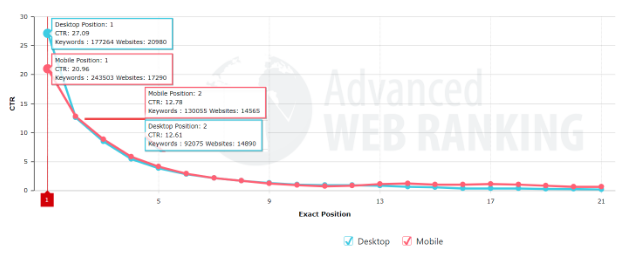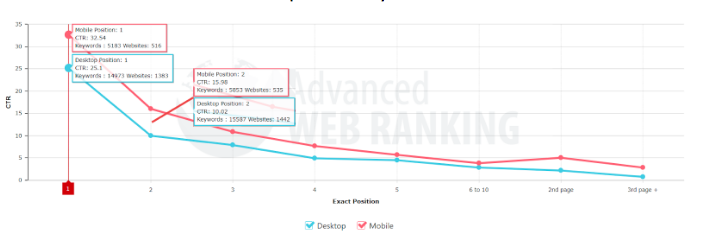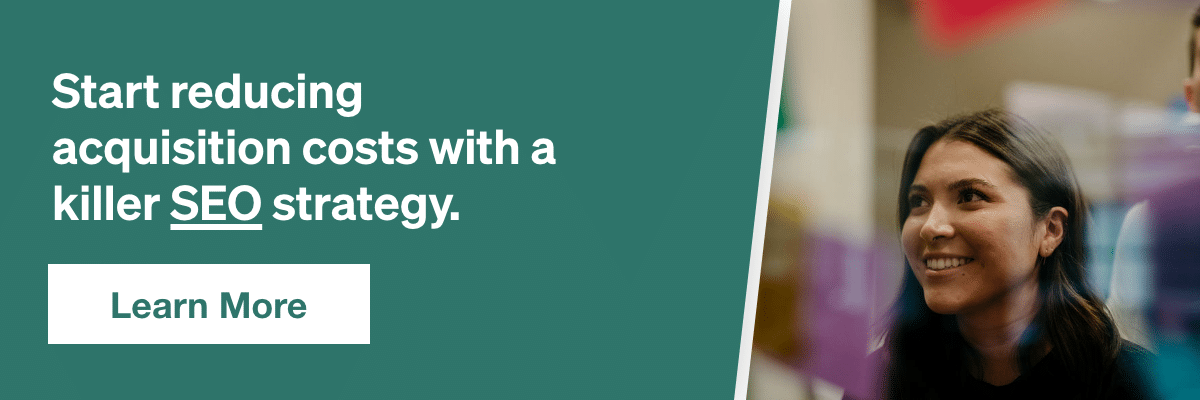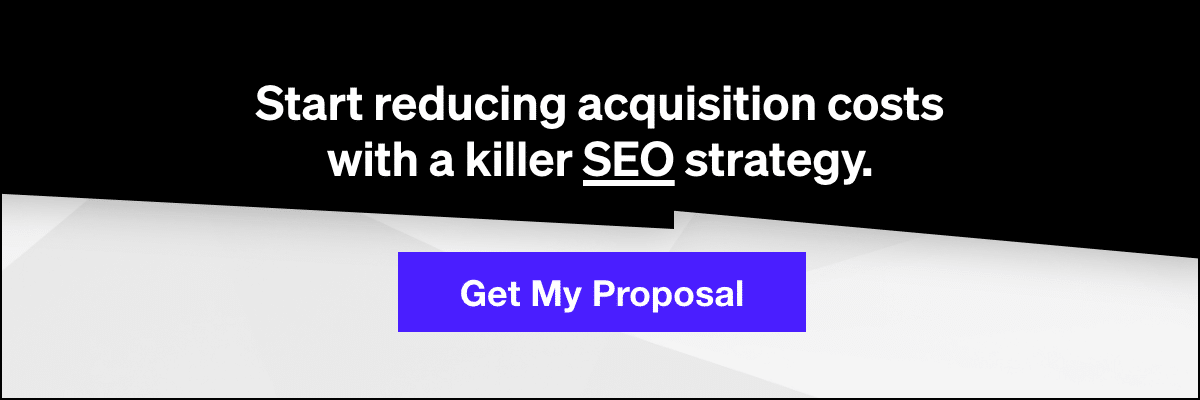As time goes on it is apparent to SEO experts that mobile has become one of the top priorities of Google each year. From the Mobile-Friendly Update (Mobilegeddon) in 2015 to the more recent Mobile-First Index, Google has been adding to the number of updates it releases regarding mobile search.
Since the vast majority of people use mobile devices to perform their searches, it is time to investigate the differences between Click Through Rate (CTR) for mobile devices compared to desktop searches. The pertinent focus should be directed toward the habits of the growing number of mobile users because it provides useful information you will need in order to develop your mobile and desktop strategies.
SEOs and Marketers alike are becoming more aware of the large differences between mobile and desktop behavior, especially how these differences will change the way we now look at SEO as a whole. The new Google mobile first update is one of the biggest contributions to the differences we see between desktop and mobile search. With the growing number of people using mobile devices it might be a good idea that we take a look at CTR and SEO for mobile devices as an increasingly significant part of business strategies.
It is not enough to rely on desktop SEO tactics for a successful holistic strategy, unless you wish to be left behind by your competitors. With the continual change in Google’s algorithms it is important to make a consistent effort to review your data in order to identify the most effective strategy for reaching and connecting with users.
We’ll address the key differences between desktop and mobile CTR. It is important to note that CTR in and of itself is different between industries, as well as between devices.
AWR Click Through Study
For this article, we used a study conducted by Advanced Web Ranking (AWR) where organic click through rates for searches coming from 1,919,943 keywords for 61,845 websites were used. As previously mentioned, click through rates vary based on industry. When it comes to a product or service it depends on how important a purchase decision is. Click through rates, in general, are typically reported to be very high for the #1 position on Google Search, accounting for approximately 20% of all clicks according to the AWR study.
US CTR Desktop Vs Mobile July 2017

Now let’s dig into the data and see what we can learn about the difference between mobile and desktop search behavior.
Not surprisingly, we find that the CTR for terms ranking in the #1 position in both desktops and mobile devices scored very well. Desktops had an impressive CTR of 27.09%, which exceeded the mobile CTR of 20.96%. Mobile search has a 39.03% decrease in CTR between position #1 and position #2, while desktop has a tremendous decrease of 53.45%. Looking back, it would seem that it was very valuable to rank in the top position, especially for desktop results.
For the second-ranking positions, we see a quick drop for both desktop and mobile to almost the same CTR. For desktop it is twice more valuable to rank in the #1 position than if you rank #2. However, for mobile, it is a little more than 1.5 times more valuable.
One additional observation to point out is that mobile has a higher click through rate than desktop for almost every position past page 1.
If we take a step back and look at the same data provided from two years ago, we see a very different picture, which then gives us an opportunity to get a clearer idea of the trends by comparison over time.
US CTR Desktop Vs Mobile July 2014

Again, we see the CTR for desktop and mobile start off very high for ranking position #1, but this time mobile seems to have much more value all the way to page 3; mobile starts at 32.54%, well above desktops 25.10%. Mobile search has a 50.89% decrease in CTR between position #1 and position #2. While desktop has a more significant decrease of 60.08%. We can now see a complete flip flop from 2014 where mobile search is dominating desktop search in the battle for ranking #1.
Mobile and desktop have a similar decline in CTR until around page 2 where mobile has an advantage over desktop.
What Is Happening?
Two years ago, people who used mobile devices for searches were normally looking for quick responses. If you were on the street looking for directions or wanted to see when the next movie showing at a nearby theater was, you didn’t want to be scrolling through heaps of irrelevant information. Now mobile users are taking more time to browse through the results and treat them similarly to that of a desktop.
Users still want quick answers and search for information that will help them right now; so the search engines are now providing more relevant results to users with mobile devices. With the information being provided to the right user at the right time and place, the user’s interactions are much more similar on both platforms.
Another contributing factor to mobile and desktop is so different, could have been that the screen size of desktops was larger than mobile devices, allowing users to read through the different links and decide which result better fits their need. Now, mobile phone screens are much larger and the content is being optimized to fit all screen sizes much more efficiently, which in turn helps the idea of mobile CTR becoming more prominent. To add to this trend, smartphones are beginning to saturate a larger demographic due to countries like India as shown in this chart by Statista. With all these new users with their cultural differences using smartphones to search, there are bound to be all new trends in mobile search for us to analyze and adapt to.
Share Of Mobile Phone Users That Use A Smartphone In India From 2014 To 2019

What Should You Do About It?
Since mobile and desktop searches are now showing up more similarly to one another compared to how they were displayed in the past, users are now treating them very much the same. However, it appears that users may be getting more relevant #1 position results for desktop search queries.
It appears that if you really want results, you have to fight for the first position no matter which device you plan to target. Mobile search has a 39.03% decrease in CTR between position #1 and position #2. While desktop has a significant 53.45% decrease; once you get past position #5 the CTR levels off and becomes fairly steady from position #9 on. The only anomaly being mobile, where it jumps back up above desktop for most of the page 2 results.
It’s crucial that you work on your website and make sure your content is fresh and impactful.
Your content must be consistently relevant throughout the site and it must meet the user’s needs. If the user is not able to obtain what they are looking for, they will quickly make the decision to move on.
Another strategy to consider is targeting long-tail keywords. Long-tail keywords can easily help you progress and advance your particular search to the top ranking. Short-tail searches tend to be more common for mobile devices. When people are trying to quickly search for something on the go they will likely shorten their terms when using mobile devices, whereas long-tail search terms tend to be more desktop oriented.
In my opinion, if you have a website that that can benefit you by being mobile it is better to optimize for mobile first then while keeping the fundamentals of desktop in mind. That way you are ready to bring in those mobile visits that are crucial to your business while still serving a great browsing experience for your desktop users at the same time. Having a mobile ready site can give you an edge up also because with the mobile first index that Google is using it will display that your site is ready for mobile visits right in the search results.
It has been said that having the mobile friendly tag on your search results will improve your mobile visits and I can not think of any reason why a user would not be reassured by seeing that your site offers a better mobile experience. Responsive web design is one of the best options due to its ease of use and divers compatibility. Responsive design works by making design and development respond to the user’s behavior and environment based on screen size, platform and orientation of the screen. This gives you the ability to deliver your products and services at a vast demographic with fairly little effort and it is a very search friendly format to use.
It is important to remember, as I have said at the beginning that this is only one instance of what mobile and desktop click through rates look like. There are a number of other variables to consider that can change the CTR dramatically. For instance, the CTR for searches that have an intent to give users information about hiking trails in the northern peninsula will have to look a lot different than the search results for users that are searching for the best price for an outdoor pizza oven.
International CTR is also much different from US, which is what I used for my data in this write up. Keep all of these factors in mind when researching and planning your optimization strategies. The mobile vs. desktop SEO landscape is a fast-paced and ever changing area of search in 2017. Click through rates are just a small part of how we look at search and what can be learned about the way people use search engines every day.









